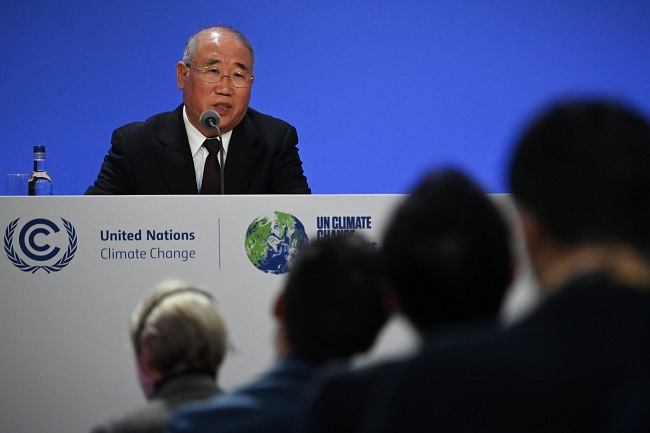The United States and China agreed on Wednesday, November 10, 2021 to “enhance ambition” on climate change, issuing a joint statement in which both countries agreed to do more to cut emissions this decade and in which China committed for the first time to address emissions from methane.

The agreement, however, did not extract any new pledges from China to peak its emissions earlier than it has already promised, or to or set a level of high how emissions will rise before peaking. China and the United States are the biggest emitters of greenhouse gases.
Xie Zhenhua, China’s climate change envoy, announced the joint “Glasgow Declaration” between the world’s two largest climate polluters. The agreement calls on both countries to strengthen their plans to cut emissions. China also agreed to “phase down” coal consumption during it’s 15th Five Year Plan, which starts in 2026.
“We both see the challenge of climate change is existential and a severe one,” Mr. Xie said. “As two major powers in the world, China and the United States, we need to take our due responsibility and work together and work with others in the spirit of cooperation to address climate change.”
Speaking after Mr. Xie, John Kerry, President Biden’s global climate envoy, said the blueprint was the result of 30 meetings between himself and Mr. Xie, as well as multiple discussions in Glasgow.
“Now the two largest economies in the world have agreed to raise climate ambition in this decisive decade,” Mr. Kerry said.
The agreement won praise among leaders and diplomats at the climate summit who said they hoped it would inject fresh energy into the global negotiations aimed at keep global temperatures from rising to dangerous levels.
António Guterres, the United Nations secretary general, called it “an important step in the right direction.” Laurence Tubiana, France’s former climate change ambassador, said it shows “that the two countries can cooperate to address the climate crisis.”
But several experts said the new pact fell far short of the agreement the United States and China made in 2014 to jointly curb emissions, a deal that helped spur the Paris climate agreement among nearly 200 nations one year later.
“While this is not a game changer in the way the 2014 U.S.-China climate deal was, in many ways it’s just as much of a step forward given the geopolitical state of the relationship,” said Thom Woodroofe, who is a former climate diplomat and a fellow at the Asia Society Policy Institute working on United States-China climate cooperation. “It means the intense level of US-China dialogue on climate can now begin to translate into cooperation.”
Manish Bapna, the president of the Natural Resources Defense Council, a Washington-based environmental group, said the agreement was “good news.” But, he said, “If we are to hold global warming to 1.5 degrees Celsius, we urgently need to see commitments to cooperate translate into bolder climate targets and credible delivery.”
Scientists have warned that allowing global temperatures to rise more than 1.5 degrees Celsius above preindustrial levels sharply increases the risk calamities like deadly heat waves, water shortages and ecosystem collapse grows immensely. The world has already warmed 1.1 degrees Celsius.
The agreement does not commit China to announce an earlier date for peaking its fossil fuel emissions. China has pledged to peak its emissions before 2030 but has not set a firm date, and American officials have been pushing their counterparts to set a clear earlier date.
“We had lots of discussions about peaking,” Mr. Kerry said. “We peaked out on peaking.” But he insisted that the agreement pushed China in the direction of bending the curve of emissions downward soon.
China also stopped short in the agreement of joining a global methane pledge that Mr. Biden announced last week, in which more than 100 countries have pledged to cut global methane 30 percent by 2030. But Mr. Xie said China would develop a “national plan” to cut methane. China’s current emissions target does not mention methane, the second most powerful greenhouse gas after carbon dioxide. Methane is the main component of natural gas and is also released into the atmosphere from landfills, livestock and thawing permafrost.
Speaking through an interpreter, Mr. Xie said, “There is more agreement between China and the U.S. than divergence.” With two days left to settle a global deal, he added, “We hope that this joint declaration can make a contribution to the success of COP26.”
Mr. Xie said the joint declaration reiterated the Paris goal of keeping global temperature rise “well below” a 2-degree Celsius rise and striving for 1.5 degrees.
“Both sides recognise that there is a gap between the current effort and the Paris agreement goals,” Mr. Xie said. He added that China and the United States had promised to work for an “ambitious and balanced” final outcome of the Glasgow summit.
By Lisa Friedman, The New York Times
